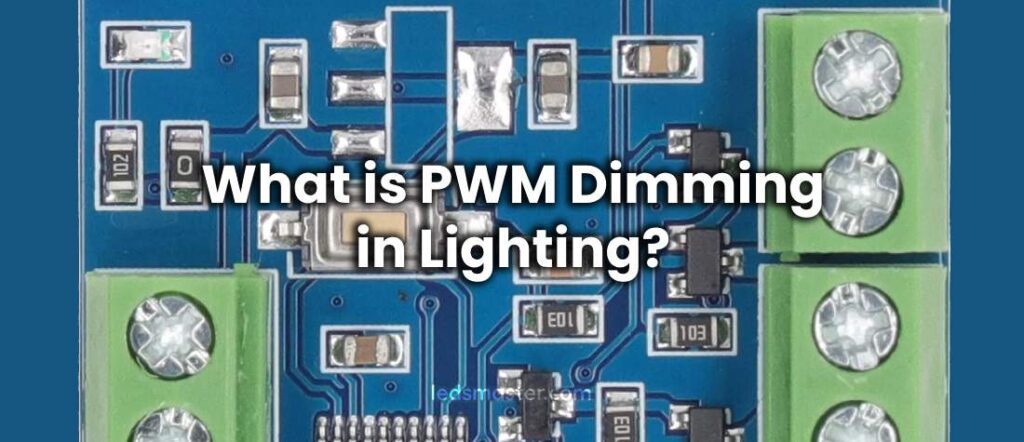Pulse Width Modulation (PWM) dimming is a pivotal technology in LED lighting, offering a sophisticated approach to controlling brightness. Understanding PWM dimming unveils its importance in enhancing energy efficiency and improving light quality. This article delves into the workings of PWM dimming, its benefits, and how it applies to LED lighting, providing a comprehensive look at why it’s a go-to method for modern lighting solutions.
Table of Contents
TogglePWM Dimming
PWM dimming is a technique used to control the brightness of LED lights by adjusting the amount of time the light is on versus off. It involves rapidly switching the LED on and off at a frequency too high for the human eye to detect. This high-speed modulation changes the perceived brightness of the light, allowing for precise control without noticeable flicker. By manipulating the duty cycle—the ratio of on-time to off-time—PWM dimming achieves varying levels of brightness.

How PWM Dimming Works
PWM dimming operates by rapidly switching an LED on and off at a frequency too high for the human eye to detect, thereby controlling its brightness. This technique adjusts the duty cycle, which is the proportion of time the LED is on relative to the total cycle time. For example, a 50% duty cycle means the LED is on for half of each cycle and off for the other half, resulting in light that appears at half of its maximum brightness. By varying this duty cycle, PWM dimming allows for precise control over light intensity, creating the illusion of continuous brightness while keeping the actual light output modulated.
This method is highly efficient as it maintains constant current through the LED but adjusts the perceived brightness by changing the on-off ratio. Unlike analog dimming, which reduces brightness by decreasing the current and generating excess heat, PWM dimming minimizes energy consumption and heat production. This results in longer LED lifespan and improved energy efficiency, making PWM dimming a preferred choice for managing LED lighting in various applications.
Advantages of PWM Dimming in LED Lighting
Enhanced Energy Efficiency
PWM dimming is highly effective in improving energy efficiency for LED lighting. By modulating the duty cycle, PWM dimming adjusts the amount of time the LED is illuminated during each cycle. When the duty cycle is lowered, the LED spends less time on, thus reducing its overall power consumption. This precise control allows LEDs to operate at reduced energy levels while still providing adequate light. As a result, PWM dimming leads to substantial savings on electricity bills. Furthermore, the reduction in power consumption contributes to a smaller environmental footprint, aligning with sustainable practices and green energy goals. This energy efficiency is a significant advantage in both residential and commercial settings, where lowering energy costs and reducing environmental impact are key considerations.
Extended LED Lifespan
Another notable benefit of PWM dimming is its positive impact on the lifespan of LEDs. LEDs are known for their longevity, but excessive heat can shorten their operational life. When LEDs are dimmed using PWM, they generate less heat compared to other dimming methods that reduce current. By decreasing the time the LED is on, PWM dimming reduces thermal stress and prevents overheating. This reduced heat output not only enhances the performance of the LED but also extends its operational life. Consequently, users benefit from fewer replacements and lower maintenance costs over time. The longevity provided by PWM dimming makes it an excellent choice for applications where long-term performance and reliability are essential.
Smooth and Flicker-Free Control
PWM dimming is renowned for its ability to provide smooth and flicker-free control over lighting. The high frequency at which the LED is switched on and off ensures that the human eye perceives a steady and consistent light output. Unlike other dimming methods that may introduce noticeable flicker or fluctuations, PWM dimming maintains a stable light quality. This feature is particularly valuable in environments where visual comfort and performance are critical, such as offices, schools, and homes. In these settings, flicker-free lighting helps reduce eye strain and enhances overall visual comfort, creating a more pleasant and productive atmosphere. The smoothness of PWM dimming ensures that lighting adjustments are seamless and unobtrusive, further adding to its appeal for various lighting applications.
Applications of PWM Dimming
Residential Lighting
PWM dimming is exceptionally valuable in residential lighting for its ability to create a customizable ambiance. Homeowners can use PWM dimming to adjust the brightness of their LED fixtures to suit different activities and moods. For a relaxing evening, the lighting can be dimmed to a warm, soft glow that fosters a cozy atmosphere. Conversely, during the morning or while performing tasks that require more light, the brightness can be increased to illuminate spaces more effectively. This flexibility allows residents to personalize their living environments, enhancing comfort and functionality. Additionally, PWM dimming helps in reducing energy consumption when the lights are dimmed, contributing to lower utility bills while providing the ideal lighting conditions for any occasion.
Commercial and Retail Spaces
In commercial and retail environments, PWM dimming offers significant benefits by enhancing both functionality and energy efficiency. In office settings, different tasks may require varying levels of illumination; PWM dimming allows for precise adjustments to suit these needs. For example, bright, focused light can be used for detailed work, while softer, ambient lighting can create a more relaxed environment for meetings or breaks. This flexibility improves the work environment and can lead to increased productivity and comfort.
Retail spaces benefit from PWM dimming by enabling dynamic lighting strategies that highlight products and create an appealing shopping experience. Adjustable brightness levels can draw attention to specific displays or create an inviting atmosphere that encourages customers to spend more time in the store. This adaptability not only enhances the visual merchandising of products but also contributes to energy savings by optimizing lighting levels according to the store’s needs.
Specialized Environments
PWM dimming is also crucial in specialized environments where precise control of lighting is essential. In medical and scientific fields, accurate lighting is necessary for tasks that require meticulous attention to detail, such as surgical procedures or laboratory work. PWM dimming ensures that lighting conditions can be finely adjusted without introducing flicker or inconsistencies that could interfere with precision work. This capability helps to reduce visual strain and maintain high standards of accuracy and safety.
In addition to medical and scientific applications, PWM dimming is beneficial in settings like photography studios or art galleries, where lighting quality and consistency are critical. The ability to fine-tune brightness levels with smooth, flicker-free adjustments ensures that the lighting conditions are optimal for capturing images or displaying artwork. Thus, PWM dimming supports both practical and aesthetic needs in specialized environments, enhancing performance and visual quality.
Challenges and Considerations
Electromagnetic Interference
Despite the advantages of PWM dimming, one significant challenge is its potential to cause electromagnetic interference (EMI). The fundamental operation of PWM dimming involves rapidly switching the LED on and off at high frequencies. This high-speed switching can generate electromagnetic noise that may interfere with nearby electronic devices, potentially leading to disruptions or malfunctions in sensitive equipment. EMI can affect various types of electronics, from audio and video equipment to communication systems. To mitigate these issues, effective design and shielding are essential. Engineers must incorporate proper filtering and shielding techniques to contain the electromagnetic emissions and prevent them from impacting other electronic systems. This careful design helps ensure that PWM dimming remains a viable option in environments where electronic interference is a concern.
Compatibility with Existing Systems
Another important consideration is the compatibility of PWM dimming with existing lighting control systems. Many older dimming systems were designed with different technologies that may not be fully compatible with PWM controls. For instance, traditional analog dimming systems, which adjust brightness by varying current, may not work seamlessly with PWM technology. This incompatibility can necessitate upgrades or replacements of existing dimming controls to integrate PWM dimming effectively. Ensuring that new dimming systems are designed to work with PWM technology is crucial for achieving optimal performance and functionality. In some cases, retrofitting older systems with compatible PWM controls may be a more practical solution, allowing users to benefit from PWM’s advantages without a complete overhaul of their lighting infrastructure.
Quality of Dimming Effect
The quality of the dimming effect produced by PWM dimming can vary depending on the design of the dimming circuitry. While PWM dimming is generally designed to be free of noticeable flicker, poorly engineered PWM circuits might still introduce subtle flicker or uneven brightness. This variability in performance is often due to the quality of the components used and the precision of the dimming controller. High-quality components and well-engineered controllers are essential to achieving a smooth and consistent dimming effect. Subtle flicker or uneven brightness can undermine the advantages of PWM dimming by impacting visual comfort and the overall lighting experience. Therefore, investing in high-quality PWM dimming systems and ensuring proper installation are crucial to maintaining the optimal performance and reliability of LED lighting applications.
Comparing PWM Dimming to Other Dimming Methods
Analog Dimming
Analog dimming is one of the traditional methods used to control the brightness of LEDs by varying the amount of current supplied to them. This approach is relatively straightforward and involves adjusting the current through a dimmer switch or control system to change the light output. As the current increases, the LED becomes brighter, and as it decreases, the LED dims.
However, analog dimming has some notable drawbacks. One significant issue is inefficiency. When the current is reduced to dim the LED, the LED’s driver circuit often needs to work harder to regulate and maintain a stable operation, which can lead to increased power loss and heat generation. This excess heat can negatively affect the LED’s lifespan and overall performance. Prolonged exposure to high temperatures can degrade the LED components, leading to reduced efficiency and a shorter operational life. Additionally, analog dimming systems may not provide as fine-tuned control over brightness levels compared to more modern methods, which can be a limitation in applications requiring precise lighting adjustments.
Digital Dimming
Digital dimming represents a more advanced approach to controlling LED brightness using digital signals. In this method, digital controllers send precise signals to adjust the light output, which can offer greater accuracy and finer control over brightness levels. Digital dimming systems are often integrated with other digital control systems, such as smart lighting setups, to provide a more sophisticated and programmable lighting experience.
Despite its advantages, digital dimming comes with its own set of challenges. The complexity of digital dimming systems typically requires more intricate circuitry and components, which can make them more expensive and potentially more challenging to install and maintain. Furthermore, while digital dimming can offer precise control and better integration with digital systems, it may not be as widely supported as PWM dimming in various lighting applications. Compatibility issues can arise if the existing lighting infrastructure is not designed to work with digital dimming systems. Consequently, while digital dimming provides advanced features and control, its implementation needs to be carefully considered in the context of existing systems and specific lighting needs.
Conclusion
Pulse Width Modulation (PWM) dimming stands out as a pivotal technology in LED lighting, offering a refined method of controlling brightness with remarkable efficiency. By adjusting the duty cycle of the LED’s on-off cycle, PWM dimming provides precise control over light intensity while minimizing energy consumption and extending LED lifespan. This technology not only enhances energy efficiency and prolongs the operational life of LEDs but also delivers smooth, flicker-free lighting, crucial for environments requiring high visual comfort. Whether applied in residential settings, commercial spaces, or specialized environments, PWM dimming proves to be a versatile and effective solution, making it an invaluable tool for modern lighting systems. Despite some challenges such as potential electromagnetic interference and compatibility issues, its benefits in energy savings, lifespan enhancement, and lighting quality solidify PWM dimming as a preferred choice for contemporary lighting needs.

